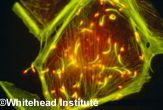
Bacteria are more gregarious than previously thought. Not only do they routinely engage in small talk among themselves, but research is showing that many are also multilingual and can communicate with members of other species.
"When we think about bacteria, we think about them as being tiny single-celled organisms that live these very asocial reclusive lives," said Bonnie Bassler, a molecular biologist at Princeton University. "In fact, bacteria have developed language, and the language is chemical."
Speaking at the annual meeting for the American Association for the Advancement of Science earlier this year in Washington, Bassler explained that in addition to being able to communicate with members of their own species, many bacteria can also talk to members of other species using a universal chemical language.
Gathering a quorum
Bacteria are able to communicate with one another through a process known as quorum sensing.
Here's how it works: Individual bacteria secrete signaling molecules called autoinducers into their environments, and as the number of bacteria in a colony increases, so does the concentration of the signaling molecule.
Once a critical mass, or quorum, of bacteria and auto inducers are reached, specific behaviors can be initiated.
Sign up for the Live Science daily newsletter now
Get the world’s most fascinating discoveries delivered straight to your inbox.
Quorum sensing allows bacteria to coordinate their behaviors on a global scale and to act like enormous multicellular organisms, Bassler explained. The types of behaviors initiated by quorum sensing are typically those that are beneficial only when performed as a group, such as the release of toxins or the formation of aggregates called biofilms.
"The goal of quorum sensing is to count," Bassler said. Bacteria in the wild are not typically found in homogenous groups, but rather coexist in diverse communities with other bacterial species. "We don't think anymore that it does bacteria any good to only count its own species; they have to be able to take a census of the rest of the population."
One way they do this is through quorum sensing. In addition to autoinducers that are species-specific, many bacteria also produce a universal autoinducer, known as AI-2, which can be understood across different bacterial species.
AI-2 was first discovered in a bioluminescent species of marine bacteria capable of giving off visible light, but it has since been identified in hundreds of other species. "This is a generic language," said Bassler. "It's the trade language that says 'other.'"
Applications
Many scientists believe the discovery of AI-2 could lead to the development of a new class of antibiotics.
"If we could keep the bacteria from talking or listening, we might be able to develop new kinds of therapeutics," Bassler said.
Because such a drug would not kill the bacteria directly, but only disrupt their activity and prevent them from releasing their toxins, it would not encourage the development of resistance--a problem that is plaguing many current antibiotics. Bassler believes there are probably other molecules like AI-2.
"There are probably many more molecules to be found that tells who the other guy is as well," she said. "We're only at the beginning of this field."
Image at top of page: Credit: ©Whitehead Institute for Biomedical Research
Small Stuff

Micromachines
Microscopic Images as Art









